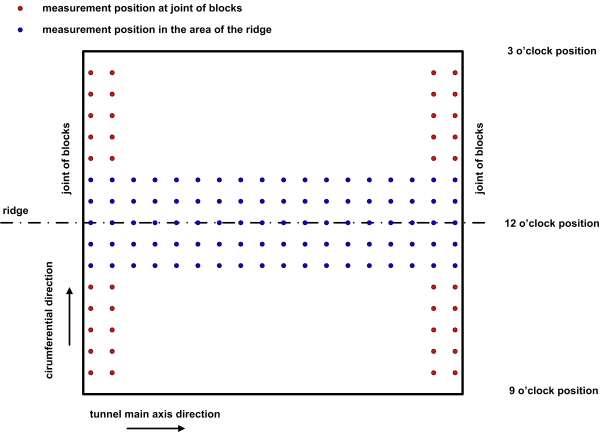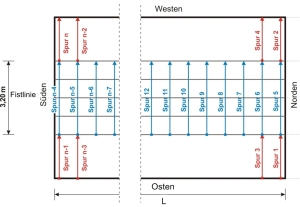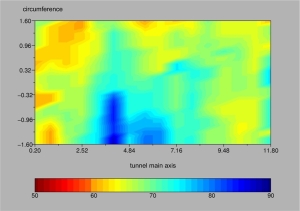Inspection of Tunnel Linings According to the German Guideline RI-ZFP-TU
The German Guideline RI-ZFP-TU
Background and Introduction of the RI-ZFP-TU
In the past leaking of tunnel linings was observed although the welded joints of the sealing were proven to be tight. Hence the leakage had to be introduced after completion of the structure. It was found that uncovered rebars on the mountain side perforated the sealing causing the damage.
Tunnels produced by mining techniques with a sealing applied at the outer, mountain-sided surface tend to leak if the reinforcement on that side is not fully covered by concrete. The damage arises when the water pressure squeezes the sealing against the uncovered reinforcement which finally causes tearing of the sealing. The position of the reinforcement structure is determined by the measurement of concrete coverage at the inner surface. If the reinforcement is placed correctly at the inner side it is also correct on the mountain-side because the rebars of the reinforcement are connected. Hence the damage may only occur in case of an unsufficient wall thickness. By means of wall thickness measurements possible areas of failure may be localized.
Non-destructive techniques localizing areas dropping below the minimum wall thickness allow the construction companies filling up the detected voids. Legal proceedings concerning warranty are avoided in a very early stage.
The German federal agency for road construction issued on 5th march 2002 the Guideline for Non-Destructive Testing of Tunnel Linings in the newsletter of the ministry of transport. This guideline is valid for all trunk roads owned by the federal government. It is the aim of that guideline to enhance the quality and lifetime of tunnels produced by mining techniques. In order to guarantee the quality of the required wall thickness measurements the tests have to be performed by approved persons. The certification is managed by Bundesanstalt für Straßenwesen (BASt).
Tunnels produced by mining techniques with a sealing applied at the outer, mountain-sided surface tend to leak if the reinforcement on that side is not fully covered by concrete. The damage arises when the water pressure squeezes the sealing against the uncovered reinforcement which finally causes tearing of the sealing. The position of the reinforcement structure is determined by the measurement of concrete coverage at the inner surface. If the reinforcement is placed correctly at the inner side it is also correct on the mountain-side because the rebars of the reinforcement are connected. Hence the damage may only occur in case of an unsufficient wall thickness. By means of wall thickness measurements possible areas of failure may be localized.
Non-destructive techniques localizing areas dropping below the minimum wall thickness allow the construction companies filling up the detected voids. Legal proceedings concerning warranty are avoided in a very early stage.
The German federal agency for road construction issued on 5th march 2002 the Guideline for Non-Destructive Testing of Tunnel Linings in the newsletter of the ministry of transport. This guideline is valid for all trunk roads owned by the federal government. It is the aim of that guideline to enhance the quality and lifetime of tunnels produced by mining techniques. In order to guarantee the quality of the required wall thickness measurements the tests have to be performed by approved persons. The certification is managed by Bundesanstalt für Straßenwesen (BASt).
Contents of the RI-ZFP-TU
The wall thickness measurement of the inner concrete linings have to be performed utilizing ultrasonic reflection or impact echo technique on a raster defined by RI-ZFP-TU. This raster consists of circumferential lines of 3.20 m length in the area of the soffit and four longer lines between three and nine o’clock at the block endings. The distance of the last line to the joint of two blocks amounts 20 cm. The lines of measurement - so called layers - are distributed along the whole tunnel soffit, the distance between the single lines should not exceed 80 cm. The following sketch shows the placement of the measurement points.

Placement of the measurement points for wall thickness measurements according RI-ZFP-TU
The measured wall thickness values have to presented graphically in a report i.e. the report has to have a map of measured wall thickness values.
Betontest - Your Partner for Tunnel Linings Inspection
Certification for Measurement and Data Analysis of Tests According to RI-ZFP-TU
Betontest Ingenieurdienstleistungen was certified by Bundesanstalt für Straßenwesen (BASt) for performing measurements and data analysis according to RI-ZFP-TU at the 17th november 2002. Since that Betontest determined the wall thickness in tunnels of more than 20 km total length. Hence Betontest is market leader in that field.
Our Technique for Wall Thickness Measurement of Tunnel Linings
Betontest makes use of an ultrasonic reflection technique for the determination of the wall thickness. Due to the inhomogeneous structure of the material concrete is difficult to test for all non-destructive methods. If accoustic methods are applied to concrete this inhomogeneity causes scattering at aggregates which complicate the interpretation of the measurement results. In order to minimise the disturbing influence of scattering Betontest performs measurements along scan paths that include the points defined by RI-ZFP-TU. By means of spatial over-sampling spatial averaging which improves the signal quality dramatically may be introduced. The following figure shows the measurement paths.
.

Measurement points according to RI-ZFP-TU
After marking the measurement grid on the concrete surface the measurements are performed along circumferential scan lines including the points sketched in the figure above. The collected data is surveyed with respect of sufficient quality immediately after measuring.
In the final report the wall thickness values are given in tabulars at the points specified by RI-ZFP-TU. In addition the results are given in form of a thickness map. The following figure shows a sample.
In the final report the wall thickness values are given in tabulars at the points specified by RI-ZFP-TU. In addition the results are given in form of a thickness map. The following figure shows a sample.

Cartographic presentation of the tunnel wall thickness
If areas where the measured wall thickness falls below the minimum allowed wall thickness Betontest may perform success controls of the filling.
Brochure
Please read our brochure Inspection of Concrete Tunnel Linings According to The German Guideline RI-ZFP-TU — The German Guideline for Non-Destructive Testing of Tunnel Linings - Samples Taken from Several Projects. We help our customers detecting areas of unsufficient wall thickness to optimize the production of tunnel linings.

